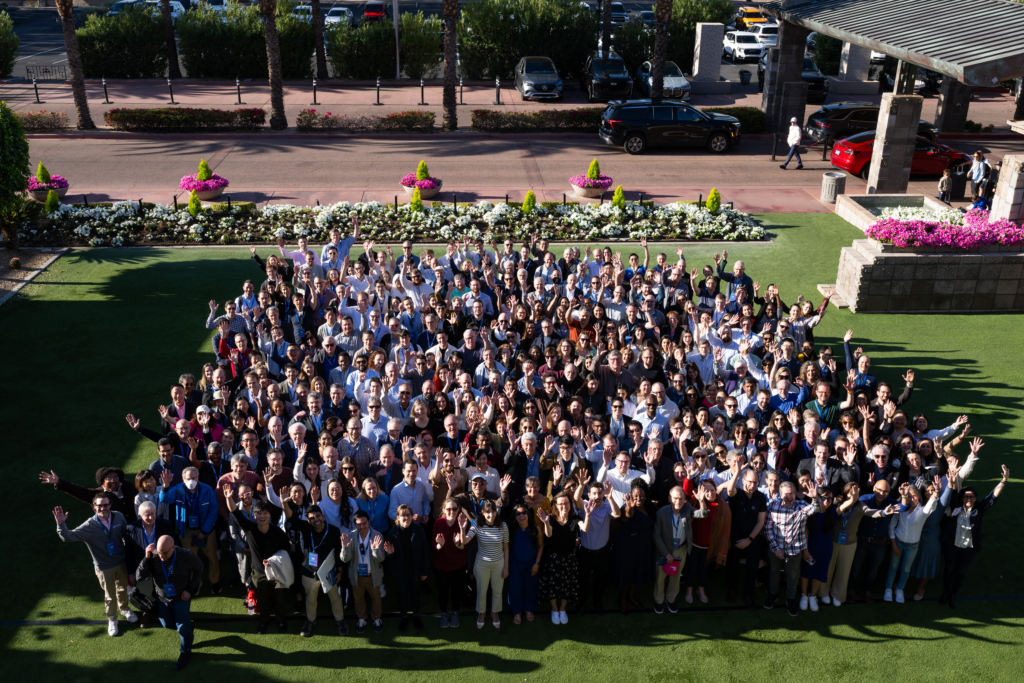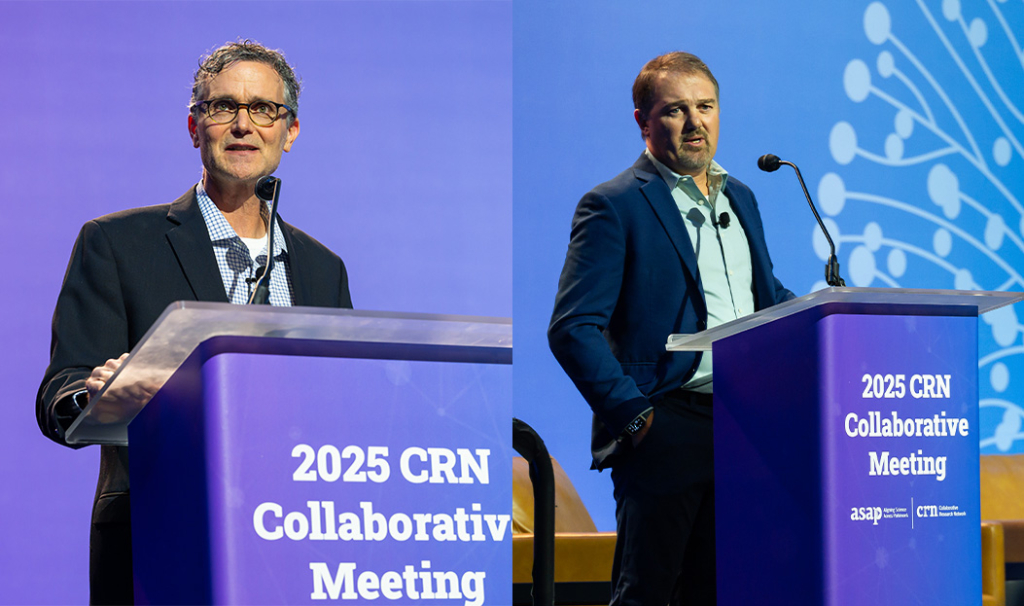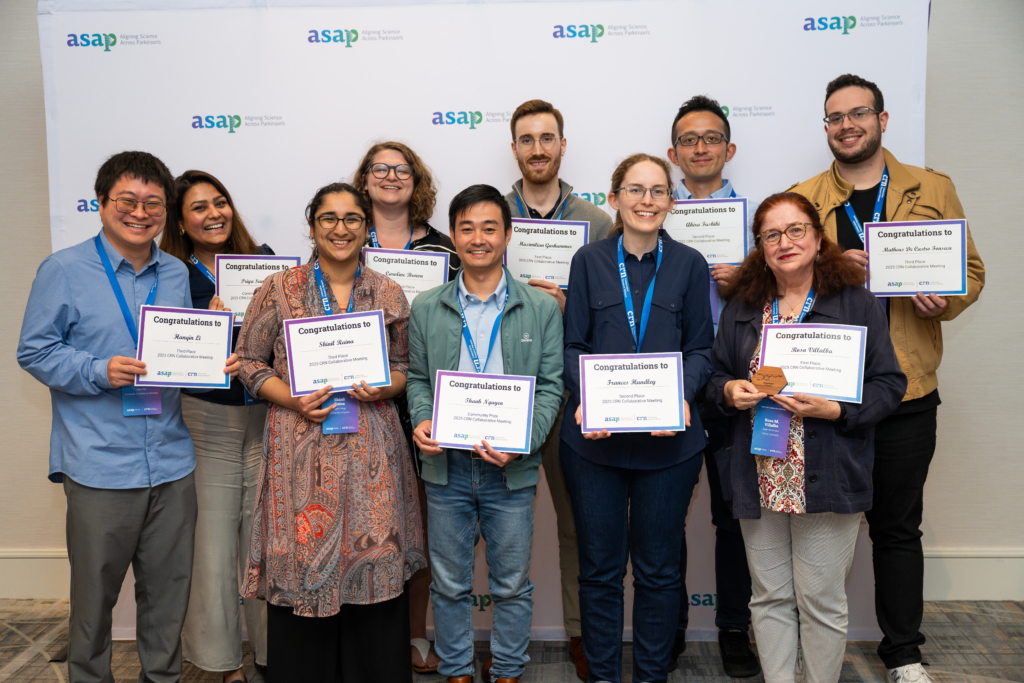The 2025 Collaborative Research Network (CRN) Collaborative Meeting was more than just a conference – it was a powerhouse of ideas, breakthroughs, and collaborations that are reshaping the future of Parkinson’s disease (PD) research. Researchers, trainees, funders, and individuals living with Parkinson’s from around the world gathered with a shared mission: to advance our understanding of PD and bring us closer to new treatments and, ultimately, a cure.
This was our largest meeting yet, with nearly 400 registered attendees and representation from all 35 CRN teams. Building upon the success of previous years, this gathering emphasized the group’s collective dedication to tackling high-priority research questions to enhance scientific discovery that one day will deliver the right drugs and interventions to the right patients at the right time.

2025 Collaborative Meeting Group Photo
This year’s meeting aimed to discuss the impactful findings on the PD landscape, promote the cross-fertilization of ideas across PD research, and provide opportunities to engage the broader CRN across different levels of training. By fostering an environment of collaboration and open communication, ASAP continues to accelerate the pace of discovery and inform the path to a cure for PD through collaboration, research-enabling resources, and data sharing.
Key Highlights:
- Big Science, Bigger Impact. The latest discoveries in PD functional genomics, neuro-immune interactions, and brain-body circuitry are rewriting what we thought we knew about Parkinson’s. Keynote speakers presented on the state of the field and shared promising news avenues for research – from emerging drug targets to known environmental risk factors associated with PD.
- Patient and Advocate Engagement. People living with Parkinson’s and their families took center stage, sharing their experiences and reinforcing why this research matters. Their stories added a human dimension to science, reminding everyone of the urgency of translating discoveries into real-world impact.
- We heard from Patrick Morrissey, who rowed the World Toughest Row with his teammates from Human Powered Potential, raising over $41 million for Parkinson’s research. Patrick’s talk taught us that by “putting yourself around the right people, you can accomplish anything.”
- We were also inspired by Ethan Henderson, who shared his journey as a patient, caregiver, and advocate. Plus, the audience was given the opportunity to hear an incredible piano solo by a father whose PD symptoms disappeared while playing the piano.

Left: Ethan Henderson Right: Patrick Morrissey
- Poster Presentations. Trainees presented groundbreaking findings on various scientific themes – Cellular Subtyping, Circuit Pathways, Immune and Gut Dysregulation, Organelle Dysfunction and Quality Control Pathways, and Pathology and Progression. These presentations showcased the CRN’s commitment to addressing high-priority research questions through multidisciplinary approaches. It was also an opportunity to celebrate the strong, diverse, global pipeline of early career scientists and the next generation of Parkinson’s researchers. The following list acknowledges eleven of our CRN team members who were honored for their remarkable research contributions.

Photo of Poster Prize Winners
First Place:
Maximilian Garhammer – Team Harper
Cassandra Nyerges – Team Surmeier
Rosa Villalba – Team Wichmann
Second Place:
Akira Fushiki – Team Surmeier
Frances Hundley – Team Harper
Caroline Brown – Team De Camilli
Third Place:
Shinil Raina – Team Cragg
Matheus De Castro Fonseca – Team Gradinaru/Sulzer
Hanqin Li – Team Rio
Community Prize:
Priya Suman – Team Schlossmacher
- Collaborative Workshops. Interactive sessions facilitated knowledge exchange and fostered new collaborations, reflecting ASAP’s mission to accelerate discovery through open science and shared resources. Trainees participated in self-selected career chats, where they had the opportunity to speak with people from various career tracks, including postdoctoral programs, open science, data management, venture capitalism, non-profit, and more. Teams also had the opportunity to engage with various ASAP Resource Teams to learn about new resources and opportunities through different types of meet-ups.
- Future Directions. Discussions highlighted the importance of sustaining momentum in PD research, focusing on integrating new technologies, expanding global partnerships, and ensuring that scientific discoveries translate into therapeutic interventions.
Collaboration at Work
ASAP’s values were on full display as teams came together to learn, share, and collaborate. In a post-event survey, 97% of attendees reported learning something new, and 80% discovered new opportunities for collaboration – many saying the meeting would reshape their future research.
Forward Together
We imagine a world where the top Parkinson’s researchers don’t just share their latest findings – they actively work together to solve the biggest mysteries in the field. The spirit of open science and collaboration makes this event unlike any other, accelerating progress in ways no single lab could achieve alone.
The CRN Collaborative Meeting isn’t just about what happens in the room but also about what happens next. By fostering collaboration, innovation, and transparency, ASAP ensures that the best ideas don’t stay locked in labs but move toward real solutions.
Whether you’re a scientist, clinician, advocate, or someone with a keen interest in Parkinson’s research, this meeting provided an opportunity to reflect on ASAP’s impact to date and explore new frontiers in our journey toward a cure.
Stay tuned, stay engaged, and let’s keep breaking barriers in the fight against Parkinson’s.

